Illinois Latina/o Students in Science Find Community, Opportunities, & Outreach Through SACNAS

During a SACNAS outreach event, Ciencias!, Materials Chemistry PhD student Elena Montoto teaches about bee honeycomb structures.
March 23, 2018
SACNAS, the Illinois chapter of the Society for Advancing Chicanos/Hispanics & Native Americans in Science, is an integral part of a number of Hispanic students' campus experience. For both graduate students, as well as undergrads, it is a support system, not only academically and professionally, but socially. Plus, for students who would like to increase the number people of color in science, it provides opportunities for outreach to youngsters, including some who look like them.
One of SACNAS' main thrusts is providing support for around 40+ Hispanic students at Illinois, both graduate students as well as an increasing number of undergrads, who are members of the student organization. With an emphasis on community, one of its chief benefits is to foster networking/relationship building among the students. For instance, in addition to its monthly general meetings, the group also tries to offer a social, networking, or professional development event every month.
The current SACNAS president is 4th-year Materials Chemistry PhD student Elena Montoto, who works in Professor Joaquín Rodríguez-López's analytical chemistry lab. Using different instruments to measure chemical reactions, she works with materials, such as polymers, her original area of interest, useful for electro-chemical energy storage and its applications.
Montoto shares what SACNAS has meant to her during her time at Illinois: “SACNAS has been great for me. I’ve kept at it since day one, basically,” she says. For instance, it’s provided her with crucial relationship-building opportunities: “This is where I’ve met most of my friends in grad school, is through SACNAS," she reports.
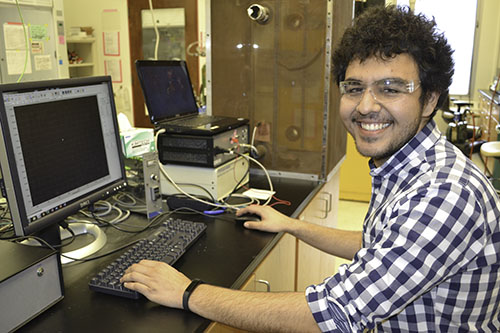
SACNAS Outreach Coordinator and 3rd-year PEEC PhD student, Alonso Favela.
Regarding SACNAS' impact, Alonso Favela, a 3rd year PhD student in PEEC (the Program in Ecology, Evolution, and Conservation Biology) and SACNAS’ Outreach Coordinator, would agree with Montoto. “It’s been community,” he reports.
Also, for Favela, SACNAS provides him a chance to interact with other Hispanics in his field.
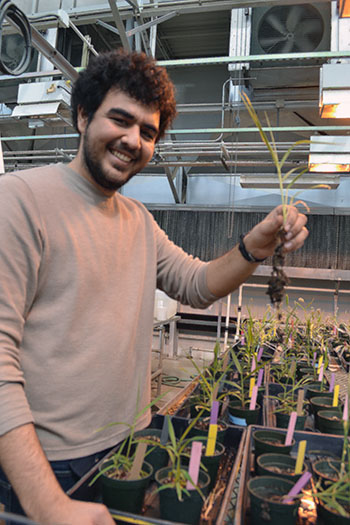
Alonso Favela shows the root system of one of the plants he's experimenting on.
“It’s weird,” he admits. “At least in my field—ecology, evolution, biology sort of stuff—there’s not a lot of people of color, period. It’s one of those fields that’s…very white male. It’s a very white field. You know, ‘We like hiking. Let’s do some ecology!’” (Favela confesses that, despite the stereotype, he does like hiking.)
So for students like Favela, in a field with very few people of color, the organization provides another key opportunity—the national SACNAS conference every October. One of the highlights of the year for SACNAS members, the conference enables students to network with people at other universities or companies. For Favela, SACNAS conferences have helped him to discover, “‘Oh, there’s other people like me at other universities! And maybe I’m the only one here, but there’s more!’ And eventually, I get to hang out with them and talk to them about science.”
Like the science he's currently researching in Professor Angela Kent’s lab: looking at how plants alter their root micro community systems with the goal of making crops more sustainable. He seeks to understand how plants interact below ground and how they use nutrients.

Students at SACNAS' recent "Ciencias!" outreach play with slime at the "States of Matter" station.
“A big goal of it, actually, is to make plants that produce less nutrient pollution,” he explains, referring to the nitrogen runoff caused by growing corn, which causes widespread nutrient pollution and wreaks havoc ecologically. “If we want to maintain this system,” he maintains, “we actually have to start focusing on how the plant does it below ground.”
Regarding additional benefits of the national conference, Montoto adds: "It’s also given me tons of opportunities.” For instance, the conference gives students a chance to present their research. In fact, Montoto indicates that it was the first conference where she got to present. Not only that, both she and Favela won awards for their oral presentations in 2016. “It’s been an integral part of my time in grad school,” she acknowledges.
In addition, attending the national SACNAS conference provides career-related perks; it sometimes leads to summer internships for undergraduates or jobs for those ready to enter the work force. Favela reports that one undergraduate student he knows who participated in the Fall 2017 SACNAS conference has an internship this coming summer as a result of attending the conference.
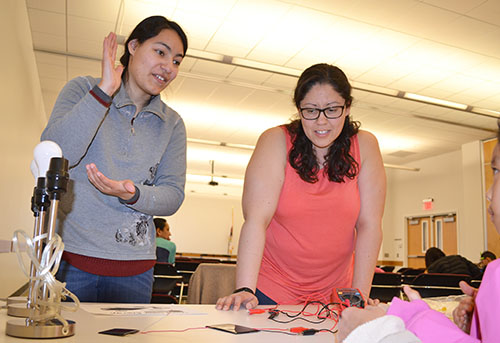
Two SACNAS members, Dalia Portillo and Brenda Andrade, teach young visitors about solar energy during the recent "Ciencias!" outreach at the Champaign LIbrary.
While SACNAS nets its members a lot of benefits, another important SACNAS emphasis is outreach—the chance to give back to the local community. So the group provides several different outreach opportunties for members, depending on how much time they have available.
For instance, SACNAS does several big outreach events throughout the year, such as the recent "Ciencias!" event at the Champaign Public Library. The outreach takes place once a semester, both in the spring and the fall. Also in the fall, the group coordinates with another group on campus for Latino Family Visit Day, during which one of the stops is a hands-on activity provided by SACNAS. Plus, SACNAS also does a monthly outreach for Urbana School District bilingual students, Cena y Ciencias (Supper and Science), where, in addition to pizza, SACNAS members provide hands-on activities completely in Spanish.
One reason outreach is such a strong emphasis for SACNAS is that most members are passionate about seeing an increase in the number of students in science—particularly Hispanic students. For instance, Montoto hopes to give today's kids opportunities she didn’t have.
“Personally, I didn’t have these opportunities growing up,” she admits. “I don’t think I ever went to a scientific demonstration of any sort when I was young."
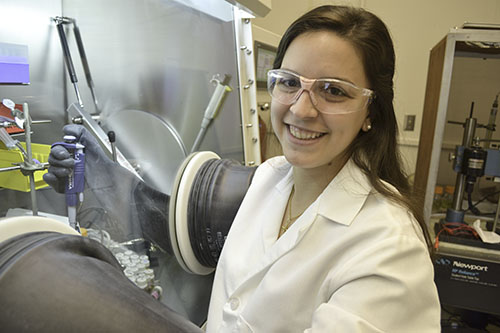
SACNAS President Elena Montoto at work Professor Joaquim Rodriguez Lopez's lab in Chemistry.
Despite not having gone to outreach events, Montoto was interested in science early. In fact, it was always her favorite subject. But how did Montoto get from an interest in science to where she is today: researching materials for energy storage solutions, such as batteries and other technologies, at large-scale installations?
She reports that, as she took courses in high school, she started to narrow down her options. For instance, she decided she didn’t want to work with living things, such as people. “Medicine, for me, just pretty much scared me,” she admits. “I didn’t want to have somebody’s life in my hands.” So she went for the hard sciences. Then, her sophomore year as an undergrad, she joined a research lab and fell in love.
“So I was able to do chemistry on my own, kind of work in the lab; work out my own problems and challenges and things, so that pretty much kept me going. After that I was, ‘I’ll go do research, work in a lab.’” In keeping with her early love of research, Montoto’s dream job is to keep doing it, either in industry or a government lab.
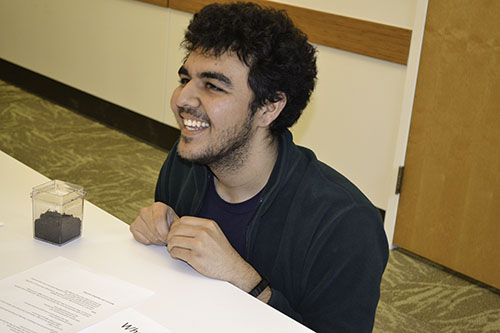
SACNAS Outreach Coordinator and third-year PEEC PHD student Alonso Favela mans the Earthworms station at SACNAS' recent Ciencias! event.
For Alonso Favela, whose dream job is to be a professor at an R1 institution, he recognizes the impact outreach can have on young students because of the impact it had on him as a child.
Like Montoto, Favela also loved science as a kid—particularly biology— which he gravitated to when participating in outreach as a child. Intending to be a medical doctor, he did his undergrad coursework in premed. However, after taking an intro biology course where he learned all about plants and how complex they are, like Montoto, he too fell in love.
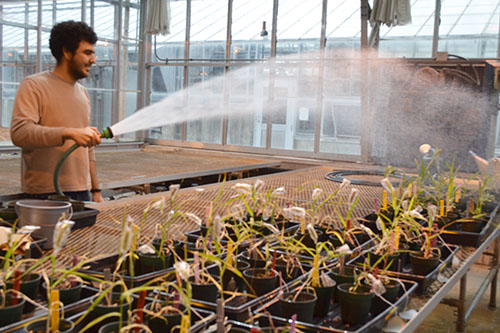
Alonso Favela waters his plants.
“I realized that I really like plants, and that they’re everywhere, and that they’re so cool! And nobody gives them enough credit!” he champions. “So I guess at some point in my undergrad, I realized that I liked spending time with plants and insects and stuff more than people.”
Story and photographs by Elizabeth Innes, Communications Specialist, I-STEM Education Initiative.
More: K-6 Outreach, SACNAS, Underserved Minorities, 2018
For another I-STEM article about Leal School and SACNAS see:
- SACNAS Advances Latina/o Students in Science Via an Outreach for Local Youngsters—Ciencias!
- Cena Y Ciencias: Supper and Science…and Role Models, Courtesy of SACNAS
- Leal Science Night Exposes Local Youngsters to STEM, Role Models

At the Solar Energy station at SACNAS' recent "Ciencias!" outreach, young students watch a SACNAS student expose a small solar panel to the "sun."













.jpg)
















